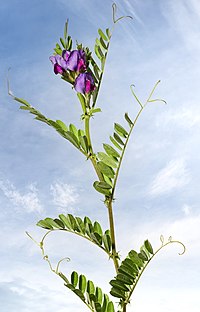
Photo from wikipedia
Multiple agricultural practices are being applied to increase crop yield in order to overcome the food shortage. Green manure has emerged as an appropriate practice to improve soil fertility and… Click to show full abstract
Multiple agricultural practices are being applied to increase crop yield in order to overcome the food shortage. Green manure has emerged as an appropriate practice to improve soil fertility and crop yield. However, the potential functions of arbuscular mycorrhizal fungi (AMF) in the below-ground ecosystems following the application of green manure in Ultisols remain largely unexplored. In this study, qPCR and high-throughput sequencing were used to investigate the response of AMF abundance and communities in different treatment groups, i.e., control (without fertilization), mineral fertilization (NPK), mineral fertilization with returning peanut straw (NPKS), and with green manure (hairy vetch; NPKG). The NPKG treatment significantly increased soil fertility compared to other treatment groups. Compared with control, the NPK, NPKS, and NPKG treatments increased peanut yield by 12.3, 13.1, and 25.4%, respectively. NPKS and NPKG treatments significantly altered the AMF community composition decreased the AMF diversity and increased AMF abundance compared to the control. The AMF network of the NPKG treatment group showed the highest complexity and stability compared to other treatment groups. The structural equation modeling revealed that the application of hairy vetch improved soil nutrients and peanut yield by increasing the soil AMF abundance and network stability. Overall, the results suggested that the application of hairy vetch might trigger positive feedback between the peanut and AMF community, contributing to fertility and yield improvement in the dryland of Ultisol.
Journal Title: Frontiers in Microbiology
Year Published: 2022
Link to full text (if available)
Share on Social Media: Sign Up to like & get
recommendations!